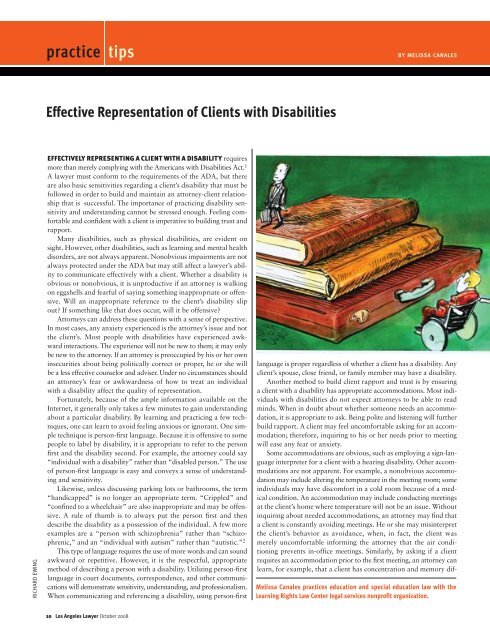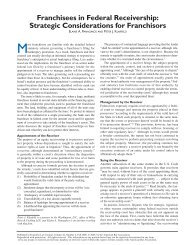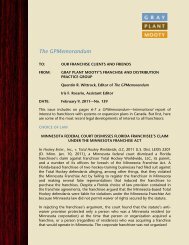Los Angeles Lawyer October 2008 - Gray Plant Mooty
Los Angeles Lawyer October 2008 - Gray Plant Mooty
Los Angeles Lawyer October 2008 - Gray Plant Mooty
You also want an ePaper? Increase the reach of your titles
YUMPU automatically turns print PDFs into web optimized ePapers that Google loves.
practice tips<br />
BY MELISSA CANALES<br />
Effective Representation of Clients with Disabilities<br />
RICHARD EWING<br />
EFFECTIVELY REPRESENTING A CLIENT WITH A DISABILITY requires<br />
more than merely complying with the Americans with Disabilities Act. 1<br />
A lawyer must conform to the requirements of the ADA, but there<br />
are also basic sensitivities regarding a client’s disability that must be<br />
followed in order to build and maintain an attorney-client relationship<br />
that is successful. The importance of practicing disability sensitivity<br />
and understanding cannot be stressed enough. Feeling comfortable<br />
and confident with a client is imperative to building trust and<br />
rapport.<br />
Many disabilities, such as physical disabilities, are evident on<br />
sight. However, other disabilities, such as learning and mental health<br />
disorders, are not always apparent. Nonobvious impairments are not<br />
always protected under the ADA but may still affect a lawyer’s ability<br />
to communicate effectively with a client. Whether a disability is<br />
obvious or nonobvious, it is unproductive if an attorney is walking<br />
on eggshells and fearful of saying something inappropriate or offensive.<br />
Will an inappropriate reference to the client’s disability slip<br />
out? If something like that does occur, will it be offensive?<br />
Attorneys can address these questions with a sense of perspective.<br />
In most cases, any anxiety experienced is the attorney’s issue and not<br />
the client’s. Most people with disabilities have experienced awkward<br />
interactions. The experience will not be new to them; it may only<br />
be new to the attorney. If an attorney is preoccupied by his or her own<br />
insecurities about being politically correct or proper, he or she will<br />
be a less effective counselor and adviser. Under no circumstances should<br />
an attorney’s fear or awkwardness of how to treat an individual<br />
with a disability affect the quality of representation.<br />
Fortunately, because of the ample information available on the<br />
Internet, it generally only takes a few minutes to gain understanding<br />
about a particular disability. By learning and practicing a few techniques,<br />
one can learn to avoid feeling anxious or ignorant. One simple<br />
technique is person-first language. Because it is offensive to some<br />
people to label by disability, it is appropriate to refer to the person<br />
first and the disability second. For example, the attorney could say<br />
“individual with a disability” rather than “disabled person.” The use<br />
of person-first language is easy and conveys a sense of understanding<br />
and sensitivity.<br />
Likewise, unless discussing parking lots or bathrooms, the term<br />
“handicapped” is no longer an appropriate term. “Crippled” and<br />
“confined to a wheelchair” are also inappropriate and may be offensive.<br />
A rule of thumb is to always put the person first and then<br />
describe the disability as a possession of the individual. A few more<br />
examples are a “person with schizophrenia” rather than “schizophrenic,”<br />
and an “individual with autism” rather than “autistic.” 2<br />
This type of language requires the use of more words and can sound<br />
awkward or repetitive. However, it is the respectful, appropriate<br />
method of describing a person with a disability. Utilizing person-first<br />
language in court documents, correspondence, and other communications<br />
will demonstrate sensitivity, understanding, and professionalism.<br />
When communicating and referencing a disability, using person-first<br />
language is proper regardless of whether a client has a disability. Any<br />
client’s spouse, close friend, or family member may have a disability.<br />
Another method to build client rapport and trust is by ensuring<br />
a client with a disability has appropriate accommodations. Most individuals<br />
with disabilities do not expect attorneys to be able to read<br />
minds. When in doubt about whether someone needs an accommodation,<br />
it is appropriate to ask. Being polite and listening will further<br />
build rapport. A client may feel uncomfortable asking for an accommodation;<br />
therefore, inquiring to his or her needs prior to meeting<br />
will ease any fear or anxiety.<br />
Some accommodations are obvious, such as employing a sign-language<br />
interpreter for a client with a hearing disability. Other accommodations<br />
are not apparent. For example, a nonobvious accommodation<br />
may include altering the temperature in the meeting room; some<br />
individuals may have discomfort in a cold room because of a medical<br />
condition. An accommodation may include conducting meetings<br />
at the client’s home where temperature will not be an issue. Without<br />
inquiring about needed accommodations, an attorney may find that<br />
a client is constantly avoiding meetings. He or she may misinterpret<br />
the client’s behavior as avoidance, when, in fact, the client was<br />
merely uncomfortable informing the attorney that the air conditioning<br />
prevents in-office meetings. Similarly, by asking if a client<br />
requires an accommodation prior to the first meeting, an attorney can<br />
learn, for example, that a client has concentration and memory dif-<br />
Melissa Canales practices education and special education law with the<br />
Learning Rights Law Center legal services nonprofit organization.<br />
10 <strong>Los</strong> <strong>Angeles</strong> <strong>Lawyer</strong> <strong>October</strong> <strong>2008</strong>







